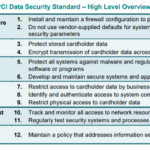Navigating the world of financial security standards can be daunting, particularly when it comes to Payment Card Industry Data Security Standard (PCI-DSS) compliance. You may stand amidst the barrage of technical jargon and wonder precisely how PCI-DSS compliance is measured. Evidence-based metrics, assessment strategies, and strict adherence to regulations all play critical roles in this process. With this article, you’ll get a crystal-clear understanding of the underlying mechanisms that measure PCI-DSS compliance, enabling you to fortify your organization’s defenses and safeguard sensitive financial data more efficiently.

Understanding PCI-DSS Compliance
When it comes to payment security, you cannot afford to be lax. An integral part of ensuring financial transactions are secure involves understanding and implementing PCI-DSS compliance measures. Managing the security of card payments, especially for enterprises that handle large volumes of transactions, is essential to ensure protection against potential breaches.
Definition of PCI-DSS Compliance
PCI-DSS stands for Payment Card Industry Data Security Standard. This is a set of security standards designed to ensure that all companies which accept, process, store or transmit credit card information maintain a secure data environment. Compliance with this standard is not an optional exercise, but rather a mandatory requirement for all businesses that handle cardholder data.
Importance of PCI-DSS Compliance
The importance of adhering to the PCI-DSS compliance cannot be overstated. Compliance ensures the protection of cardholder data, thereby ensuing trust in your business’ payment system from both card brands and consumers alike. Noncompliance could result in severe financial penalties, damage to your brand’s reputation, and can even lead to the loss of your ability to process card payments.
Key Principles of PCI-DSS Compliance
Building and Maintaining a Secure Network
The first key principle of PCI-DSS compliance involves ensuring your network is secure. This means implementing firewall configurations to protect data, and creating custom passwords and other security parameters instead of the default ones provided by vendors.
Protecting Cardholder Data
Protecting stored cardholder data is another critical principle. This entails encrypting transmission of cardholder data across public networks, thereby ensuring it is unreadable to unauthorized parties.
Managing Vulnerabilities
Managing vulnerabilities is a crucial part of PCI-DSS compliance. This involves using and regularly updating anti-virus software, developing and maintaining secure systems and applications, and ensuring all system components and software are protected against known vulnerabilities.
Applying Access Control Measures
Access control measures should be put in place to ensure data can only be accessed on a “need-to-know” basis. Unique IDs must be assigned to each person with computer access, and physical access to cardholder data should be restricted.
Monitoring and Testing Networks
Regular monitoring and testing of networks are essential in order to track and monitor access to network resources and cardholder data. This ensures vulnerability management processes, including regular testing of systems and processes, are in place.
Maintaining an Information Security Policy
A strong information security policy is paramount as per the PCI-DSS compliance guidelines. This must be maintained, disseminated and reiterated to all relevant personnel.
PCI-DSS Compliance Levels
Depending on the volume of transactions your organization processes, you may fall under different PCI-DSS compliance levels.
Level 1 Compliance
Level 1 compliance applies to merchants processing over 6 million card transactions per year across all channels or any merchant that Visa deems as a Level 1. Such merchants will require an annual Report on Compliance (RoC) by a Qualified Security Assessor (QSA).
Level 2 Compliance
Level 2 compliance is for merchants processing 1 to 6 million card transactions per year across all channels. These merchants must complete an annual Self-Assessment Questionnaire (SAQ), along with a quarterly network scan by Approved Scan Vendor (ASV).
Level 3 Compliance
Merchants who handle 20,000 to 1 million Visa e-commerce transactions per year fall into Level 3 compliance. Compliance requirements are the same as Level 2.
Level 4 Compliance
Level 4 applies to merchants processing fewer than 20,000 Visa e-commerce transactions per year, and all other merchants processing up to 1 million Visa transactions per year. Compliance measures are the same as for Level 2 and 3 merchants.
Measuring PCI-DSS Compliance
Several measures are used when assessing PCI-DSS compliance, and these vary based on the level of compliance required.
Annual PCI Self-Assessment Questionnaire
This is a validation tool to assess a merchant’s compliance with PCI-DSS requirements. It is usually used by Level 2-4 merchants.
Network Security Scans
Quarterly network scans are required for Level 1-4 merchants. These scans are also performed by an Approved Scan Vendor (ASV) to identify vulnerabilities.
On-site Reviews
On-site reviews by a Qualified Security Assessor (QSA) or internal auditor, if signed by an officer, are required for Level 1 merchants.
Attestation of Compliance
This is a form that must be completed and signed by the merchant, stating that they have taken all necessary steps to achieve full PCI-DSS compliant status.
Annual PCI Self-Assessment Questionnaire
The Annual PCI Self-Assessment Questionnaire (SAQ) is a crucial tool in verifying your ongoing compliance with PCI-DSS standards. It is self-administered and serves to educate merchants on the types of technology and processes needed to secure payment card transaction environments.
Understanding the Self-Assessment Questionnaire
The SAQ includes a series of yes-no questions for each applicable PCI-DSS requirement. Each question is designed to gauge your organization’s compliance level.
Completing the Self-Assessment Questionnaire
Upon completion, the SAQ will give you an idea of whether your organization is compliant, and if not, what areas need improvement. While it provides a guideline, it’s crucial that honest answers are provided.
Assessing the Results of the Self-Assessment Questionnaire
The results of the SAQ can be used to identify any areas of non-compliance and develop a remediation plan. Depending on your answers, you may need to engage with a Qualified Security Assessor (QSA) to achieve full compliance.
Network Security Scans
As part of your PCI-DSS compliance, quarterly network security scans are mandatory. These scans aim to identify and rectify any potential vulnerabilities which could be exploited to access cardholder data.
Importance of Network Security Scans
These scans are a crucial line of defense for identifying potential vulnerabilities and ensuring the ongoing security of cardholder data. They help detect and rectify vulnerabilities before they can be exploited.
Frequency of Network Security Scans
As stipulated by the PCI-DSS, these scans must be carried out quarterly by an Approved Scanning Vendor (ASV). However, it’s recommended that scans are performed more frequently to ensure the ongoing integrity of your network.
Interpreting the Results of Network Security Scans
Security scans provide a detailed report on any detected vulnerabilities, which can then be analyzed and addressed appropriately. It’s crucial to understand and take mitigating actions based on these scan results to maintain PCI-DSS compliance.
On-site Reviews
On-site reviews are a critical component of Level 1 PCI-DSS compliance, with the aim to critically assess and verify a merchant’s adherence to the PCI-DSS.
Role of On-site Reviews in PCI-DSS Compliance
Conducted by a Qualified Security Assessor (QSA), or an internal auditor, on-site reviews play a critical role in verifying the integrity of the physical and logistical components of cardholder data protection.
Conducting On-site Reviews
The on-site review involves robust inspection of all system components within the payment card environment, from hardware to operational procedures. It serves to scrutinize the effectiveness of the implemented security measures.
Utilizing On-site Review Results
The results from the on-site review provide valuable insight into your organization’s security posture. These results should be used to identify and correct any issues, ensuring that you maintain PCI-DSS compliance.
Attestation of Compliance
The Attestation of Compliance (AoC) is a declaration from the merchant or the service provider about their PCI-DSS compliance status.
The Purpose of the Attestation of Compliance
The main purpose of the AoC is to provide proof that a company has securely handled cardholder data in accordance with PCI-DSS requirements. This document is to demonstrate to acquiring banks and payment brands that the company is compliant.
Processes Involved in the Attestation of Compliance
The AoC process requires an official validation of compliance by a Qualified Security Assessor (QSA) or for Self Assessment Questionnaire by an ASV, which is then signed by an officer of the company.
Possible Outcomes of the Attestation of Compliance
The successful completion of an AoC indicates that a company is following the necessary steps to protect customer cardholder data. If a company does not successfully complete the AoC, they are considered non-compliant, which can lead to penalties.
Non-Compliance Penalties
Non-compliance with the PCI-DSS requirements can have numerous ramifications for a company.
Financial Penalties for Non-Compliance
Non-compliance can result in severe financial consequences from penalties and fines imposed by the payment card industry, which can range from $5,000 to $100,000 per month.
Reputation Damage due to Non-Compliance
In addition to financial penalties, non-compliance can also lead to severe reputational damage. Such damage can lead to a reduction in customer confidence and subsequently, revenue loss.
Loss of Business due to Non-Compliance
In the worst-case scenario, non-compliance could result in your business losing the ability to accept card payments. Such an outcome could be catastrophic, potentially leading to the end of your business operations.
Conclusion: Maintaining PCI-DSS Compliance
Maintaining PCI-DSS compliance does not stop at the successful achievement of compliance. Rather, it is an ongoing process that requires continuous monitoring, review, and adjustment of your security measures.
Continued Monitoring for Compliance
Perform continuous monitoring of all system components to promptly detect and react to any security threats. Regular assessments will help sustain your compliance status and ensure that your security measures are reliable and effective.
Regular Review of Compliance Measures
Periodic reviews of compliance measures are crucial to keep up with the evolution of threats and changes within the payment card industry. These reviews provide an opportunity to enhance your security framework and mechanisms.
Adjusting Compliance Strategies to Meet Changing Circumstances
Given the dynamic nature of security threats and business operating conditions, it is vital to adjust your compliance strategies accordingly. Regularly review and update your security policies and operational procedures to maintain the integrity of cardholder data.
Understanding and adhering to PCI-DSS compliance is not just about fulfilling a legal obligation. It is about securing your organization’s operations, maintaining customer trust, and protecting your business reputation. Though the compliance journey may seem challenging, the resultant fortified security is the key to the long-term sustainability of your business.













[…] the Payment Card Industry Data Security Standard (PCI-DSS). The article “Understanding partial compliance in PCI-DSS for Businesses” provides a comprehensive insight into the intriguing concept of […]
[…] and mitigating potential financial losses. Through boosting structural security measures, PCI-DSS compliance helps businesses meet the legal obligations, reducing the risk of security […]
[…] primary role of a QSA is to assist businesses in achieving and maintaining PCI-DSS compliance. This includes conducting on-site audits, identifying vulnerabilities, recommending changes, and […]